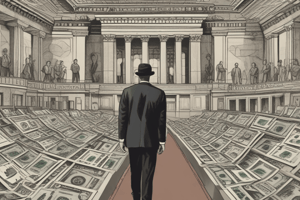Podcast
Questions and Answers
How does the Federal Reserve primarily influence the money supply through open market operations?
How does the Federal Reserve primarily influence the money supply through open market operations?
- By directly controlling the amount of currency printed at the Bureau of Engraving and Printing.
- By buying or selling government securities to banks and the public. (correct)
- By mandating specific lending quotas for commercial banks.
- By setting the interest rates that commercial banks charge their customers.
A decrease in the reserve requirement set by the Federal Reserve would likely lead to a decrease in the amount of funds banks have available to lend.
A decrease in the reserve requirement set by the Federal Reserve would likely lead to a decrease in the amount of funds banks have available to lend.
False (B)
What role does the discount rate play in the Federal Reserve's function as a 'lender of last resort'?
What role does the discount rate play in the Federal Reserve's function as a 'lender of last resort'?
setting a floor for capital needs
When the Fed buys US securities, customers receive currency for the piece of paper, a process known as monetary ______.
When the Fed buys US securities, customers receive currency for the piece of paper, a process known as monetary ______.
Match each action by the Federal Reserve with its intended impact on the money supply:
Match each action by the Federal Reserve with its intended impact on the money supply:
Which of the following scenarios would most likely lead to a bank run?
Which of the following scenarios would most likely lead to a bank run?
A price floor set below the equilibrium price will have a significant impact on the market.
A price floor set below the equilibrium price will have a significant impact on the market.
Explain how an increase in the required reserve ratio affects the lending capacity of banks.
Explain how an increase in the required reserve ratio affects the lending capacity of banks.
The measure in which prices are quoted is known as a(n) ______.
The measure in which prices are quoted is known as a(n) ______.
Match the following concepts with their descriptions:
Match the following concepts with their descriptions:
Which of the following is NOT one of the three primary functions of money?
Which of the following is NOT one of the three primary functions of money?
Producing inside the Production Possibilities Frontier (PPF) indicates efficient use of resources.
Producing inside the Production Possibilities Frontier (PPF) indicates efficient use of resources.
Explain the concept of 'moral hazard' in the context of economic policy.
Explain the concept of 'moral hazard' in the context of economic policy.
Flashcards
Federal Reserve (The Fed)
Federal Reserve (The Fed)
The central bank of the U.S., responsible for monetary policy.
Monetary Policy
Monetary Policy
Adjusting the money supply and interest rates to influence economic activity.
Fed Funds
Fed Funds
Funds that commercial banks deposit at the Federal Reserve.
Fed Funds Rate
Fed Funds Rate
Signup and view all the flashcards
Discount Rate
Discount Rate
Signup and view all the flashcards
Demand
Demand
Signup and view all the flashcards
Supply
Supply
Signup and view all the flashcards
Equilibrium Price
Equilibrium Price
Signup and view all the flashcards
Equilibrium Quantity
Equilibrium Quantity
Signup and view all the flashcards
Consumer Surplus
Consumer Surplus
Signup and view all the flashcards
Price Floor
Price Floor
Signup and view all the flashcards
Price Ceiling
Price Ceiling
Signup and view all the flashcards
Sticky Inflation
Sticky Inflation
Signup and view all the flashcards
Study Notes
-
Demand refers to the various quantities of a good or service that people are willing and able to purchase at different prices.
-
Supply refers to the various quantities of a good or service that sellers are willing and able to sell at different prices.
-
Equilibrium price is the price at which the quantity demanded is equal to the quantity supplied.
-
Equilibrium quantity is the quantity of a good or service bought and sold at the equilibrium price.
-
Consumer surplus measures the economic welfare people gain from purchasing and consuming goods and services.
-
Consumer surplus is represented on a graph as the area under the demand curve and above the market price.
-
A price floor is a minimum price imposed by the government on a good or service.
-
A price ceiling is a maximum price imposed by the government on a good or service.
-
A production possibilities frontier (PPF) illustrates the maximum combinations of two products that an economy can produce.
-
An economy cannot produce beyond its PPF due to limited resources.
-
Producing below the PPF indicates inefficient use of resources.
-
Sticky inflation refers to when inflation increases rapidly but does not decrease as quickly.
-
The three key measures of labor market activity are the unemployment rate, the labor force participation rate, and the employment-to-population ratio.
-
Money serves three primary functions: as a medium of exchange, a unit of account, and a store of value.
-
A medium of exchange is an item that buyers use to pay sellers when purchasing goods and services.
-
Barter is the direct exchange of goods or services without using a commonly accepted medium of exchange like money.
-
A unit of account is the standard measure in which prices are quoted and economic value is measured.
-
A store of value is a way to hold wealth over time.
-
M1 is the most narrowly defined measure of the money supply, including currency and checkable deposits.
-
M2 includes all of M1 plus less liquid assets like savings accounts, money market mutual funds, and small time deposits.
-
A bank run occurs when many depositors try to withdraw their funds simultaneously, often driven by fear and a desire to be first.
-
A higher required reserve ratio means banks have less money available to lend.
-
Banks may hold excess reserves if they are concerned about repayment risks.
-
The Federal Reserve (the Fed) can lower the reserve ratio to loosen monetary policy, allowing banks to lend more.
-
Moral hazard arises when individuals or institutions take on more risk because they know they will be protected from any negative consequences.
-
The Federal Reserve (the Fed) conducts monetary policy to adjust the money supply and stabilize macroeconomic trends.
-
The Fed acts as the central bank, holding deposits for commercial banks and lending them money.
-
The Fed regulates banks to ensure financial stability and sets reserve requirements.
-
Fed Funds are funds held by commercial banks at the Federal Reserve.
-
The Fed Funds Rate is the interest rate that banks charge each other for the overnight lending of reserves.
-
Discount loans are loans from the Federal Reserve to commercial banks.
-
The discount rate is the interest rate the Fed charges on these loans, acting as a floor for capital needs.
-
Banks generally avoid borrowing from the Fed due to the potential stigma.
-
Open market operations involve the Fed buying or selling government securities to influence the money supply.
-
The Fed selling US securities decreases the money supply.
-
The Fed buying US securities increases the money supply.
-
The Fed uses three main tools to manage the money supply: Open Market Operations, Reserve Requirements, and the Discount Rate.
-
The PPF is drawn as a curve because of the of the law of increasing opportunity costs.
Productive efficiency means that you cannot produce more of one good without decreasing the quantity of another. Allocative efficiency means that a combination of goods on the PPF represents the combination that people most desire.
In the goods market households are demanders while firms are suppliers. In the labor and financial markets households are suppliers while firms are demanders.
if the interest rate is above the equilibrium then an excess of supply will occur, while if it is below it there will be an excess of demand.
Studying That Suits You
Use AI to generate personalized quizzes and flashcards to suit your learning preferences.





